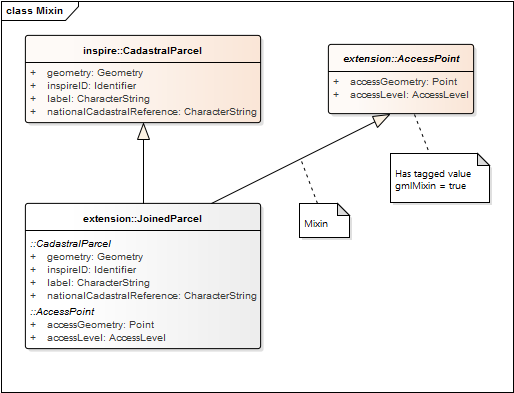class Multiple Inheritance
• Thorsten Reitz
Intent
In multiple inheritance, the class we design is composed of properties of multiple other classes. In multiple inheritance, there is no clear inheritance hierarchy anymore, which may lead to conflicting concepts. Therefore multiple inheritance is not recommended, however there are several mechanisms for multiple inheritance, one of which is called Mixin, that are useful. Each mixin is a collection of methods or properties that can be injected into the new class. Mixins are typically narrow in scope and not meant to be extended by themselves.
In INSPIRE, we can use mixins to reuse both INSPIRE specifications and local specifications, and to make sure our new class is syntactically compatible to both.
Variant: Realization
Realization is a fine-grained type of (multiple) inheritance, where one set of classes represents a specification and another set of classes represents the implementation of that specification. We often use Realization to specify a set of operations, which multiple implementations realize. A single implementing class can thus realize a subset of an INSPIRE class. This type of association will not create an INSPIRE compliant model, but will be useful when the extended model has stronger semantics than the INSPIRE class that is realized.
We recommend to limit usage of this type of inheritance, as the Realization association is mostly used for the modelling of behaviour, not of structure.
Structure
In this pattern, there is a child class, at least one mixin class and an optional parent class. The child class and the mixin class are connected through a Generalisation association which points from the child to the mixin. In this example, we add information on the position and level of access to our classes by mixing in a class called AccessPoint:

JoinedParcel inherits all properties from CadastralParcel and mixes in AccessPoint. Note that the mixin class association has a tag set to indicate the mixin approach.When to use
In the context of an INSPIRE Data Specification Extension, there are two cases where multiple inheritance via mixin can be effective:
- Your class should be compatible with an INSPIRE class and local standard classes.
- You want to use a common set of properties with consistent property names to new multiple subclasses of INSPIRE classes.
When not to use
Support for multiple inheritance via mixin varies greatly across different implementation platforms and can be complex to realize, which is the main downside. There are also other indicators when not to use mixins:
- When one of the other patterns also satisfies your requirements.
- You want to use multiple classes from the same hierarchy, as mixing them in will result in duplication or overloading.
- You need to bring in a single property or a set of unrelated properties from the mixin(s)
- You want to have the mixin conceptual relationship to be present in the implementation as well
XML Schema Example
There is no direct support for multiple inheritance or mixins in XML Schema. A common approach is to do a schema generation that copies the properties and methods of the mixin to the new class. Shapechange is able to do this when you add a UML tag to the mixin class: gmlMixin = true. The result looks as in this example:
In the example, we make our new class JoinedParcel accessible by copying the two properties accessGeometry and accessLevel from the class AccessPoint. Note that that the AccessPoint is abstract; it’s not intended to be used directly to create objects using it.
XML Instance Example
Instances using this pattern have a simple structure in which the properties inherited through mix-in can usually be identified through their namespace prefix:
Implementation Considerations
This section provides information when and how this pattern can be implemented on different types of platforms.
| Mixin is the least commonly used class extension pattern and is not supported directly in most implementation platforms. |
Storage Backend
There is no storage backend type available that supports mixins directly. In any kind of relational or document-oriented storage, the information about the mixin structure would be lost. Usage of the pattern has no averse effect on storage size.
Download Services
As there is no direct support of mixins or multiple inheritance in XML Schema, a Download Service implementation will not reflect the mixin conceptual schema directly. You will have to define which pattern of schema transformation you want to use:
- Use named model groups and named property groups
- Copy properties from the mixin class to the target class
Business Logic
Some programming languages either provide support for mixins directly or through extensions.
Consumer Side
No GIS client software is able to directly work with Mixins. As for the storage backend and download services, clients will interpret the instance documents with normal properties, and not be able to usnerstand that there was a mixin at the level of the conceptual schema.